JuJu Smith-Schuster is seated by his locker at the Chiefs’ practice facility one afternoon in early December, nodding along to a reporter’s opening line of inquiry: Given his well-documented passion for anime—as a rookie in 2017, he celebrated a touchdown catch by mimicking a Dragon Ball Z attack move—to which of his favorite character ensembles would Smith-Schuster compare himself and his fellow Kansas City wide receivers?
It takes less than two seconds of thought before his eyes light up. “Ooh, ooh, we’ll be the Akatsuki clan. They’re these rogue ninjas who all have their own superpower, and they all left their own villages to become part of this group, the baddest of the baddest group. And nobody’s messing with them.”
In the classic Japanese manga Naruto, later developed into a TV show and film franchise, among the world’s most fearsome outfits was an elite syndicate of shinobi that called itself Akatsuki, which literally means “Daybreak” but also—if read as the sum of its parts, “Aka” and “Tsuki”—can translate to “Red Moon.” Both images were reflected by the logo affixed to each ninja’s uniform, resembling a foreboding, blood-crimson cloud. Or, if the imagination stretches a bit, an upside-down football helmet.
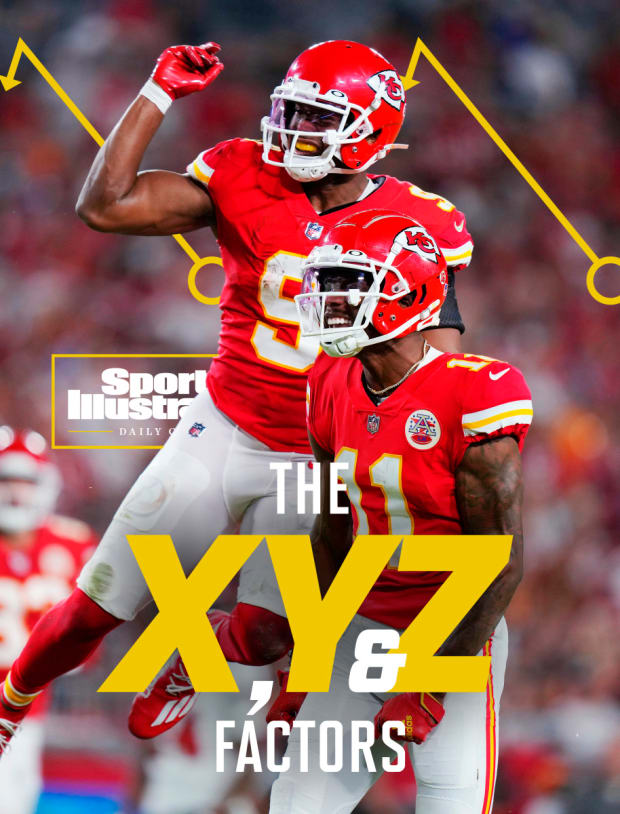
Peter Joneleit/AP/Shutterstock
Last spring, a hailstorm of hands-for-hires landed in the Chiefs’ receiving room, merging forces to help fill the star-sized hole left by the team’s trade of Tyreek Hill to the Dolphins. Never with Patrick Mahomes as its starting quarterback has Kansas City welcomed more than two new wideouts in an offseason. Now Mahomes is throwing to five of them: free agent signees Smith-Schuster (now 26), Marquez Valdes-Scantling (28) and Justin Watson (26); second-round rookie Skyy Moore (22); and late-October trade acquisition Kadarius Toney (23).
At first statistical blush, this quintet of rogues might seem relatively unremarkable. Mahomes has been his usual MVP-caliber self, leading the Chiefs to a seventh straight division title and the AFC’s No. 1 seed. But just over half of his 5,250 passing yards (50.5%), less than half of his 435 completions (45.1%) and only 13 of his 41 touchdowns (31.7%) have gone to players listed at the receiver position—rates that respectively rank next to last, next to last, and last among the 14 playoff teams. (By comparison, superstar tight end Travis Kelce caught a career-high 12 touchdowns himself.) All told, aside from the run-happy Ravens, no team targeted its wideouts less than the one that finished this season as the league’s top-ranked offense in terms of total yardage, passing and scoring.
And yet, entering a divisional playoff matchup against the Jaguars, the Chiefs’ receiving corps has also never been more dangerously deep; this year, for the first time in his NFL career, Mahomes has thrown multiple touchdowns to five receivers, led by lone holdover Mecole Hardman (four) and Smith-Schuster (three). It is an unsung group, one that lacks in national hype (if not hyphens). But together they have breathed personality into the roster, complemented Kelce and brushed aside any doubts about how they would fare in Hill’s stead. As Mahomes recently put it on Kelce’s podcast, “They got a bad rap coming into the season. I was looking at it, and I know Travis was looking at it,like, ‘Man these guys can ball, I don't know what everybody’s talking about.’”
As Smith-Schuster says now, “Everyone’s different in their own way, and everyone has different powers. That’s why I chose the Akatsuki clan, because”—and here the wideout makes a hard cut from the world of anime to the animal kingdom—“we’re just awesome dogs. There’s some dogs in this room.”
Listening from the adjacent locker stall, Valdes-Scantling begins to loudly bark.
As a member of the Buccaneers’ practice squad at the end of the 2021 season, his fourth with the franchise, Watson was immediately eligible to sign elsewhere in free agency after Tampa lost to the Rams in the divisional round. Surveying the landscape of possible destinations, Watson initially dismissed the Chiefs as a legitimate landing spot. “They didn’t really look like a team that needed receivers,” Watson says. “They were heading into the AFC championship and had the whole ring of guys that had been there the last couple years.”
That changed in the wake of said AFC title game, a disastrous 27–24 loss to the Bengals during which Mahomes completed 8 of 18 passes for just 55 yards, committed two turnovers and took four sacks in the second half and overtime. No single throw better reflected the passing game’s sudden struggles than Mahomes’s last attempt of that season, a deep heave intended for Hill in double coverage that was instead intercepted. “My agent was speaking to [Chiefs GM Brett] Veach right after they got eliminated,” Watson says. “I just wanted to know I was gonna get an opportunity. Veach said, ‘We’re gonna have that here. There’s gonna be some moving pieces in the offseason.’”
Sure enough, a little more than month later, Kansas City shipped off Hill—whose nearly 200 total catches, 2,500-plus yards, and 24 touchdowns over the past two seasons were far and away tops among Chiefs receivers—for five picks (and significant future salary-cap flexibility). Then Byron Pringle and Demarcus Robinson, whose five and three regular-season touchdowns, respectively, had ranked third and fourth on the roster, departed in free agency. “I thought I was gonna come compete for a job in a crowded room with a lot of familiar faces,” says Watson, who signed a one-year, $1.035 million non-guaranteed deal in early February 2022. “Then Mecole was about the only guy who’d been here.”
Watch the Chiefs with fuboTV. Start your free trial today.
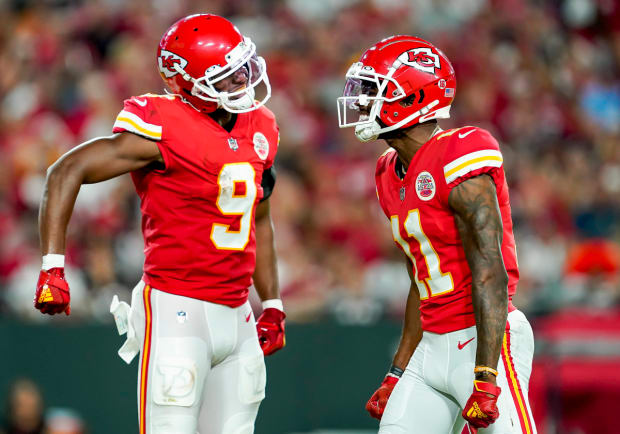
Andrew Bershaw/Icon Sportswire/Getty Images
Reinforcements were swiftly en route. On March 20, after spending his first five NFL seasons with the Steelers, Smith-Schuster signed for one year and $2.49 million guaranteed. Four days later Valdes-Scantling followed, for $15 million guaranteed over three years, rejecting a shorter-term offer to return to the Packers for a fifth campaign. Alongside Hardman, a second-round pick in 2019, the additions formed a by-committee approach to replacing Hill’s production—as well as a cost-effective one, considering the $120 million extension that Hill promptly inked with the Dolphins. But the challenge of integrating so many fresh faces at once remained. “We were all new, we all had to learn the offense, and we knew that we had a lot of work to do to get this chemistry down,” Watson says.
For Watson, the lab work started with a text from Mahomes requesting his presence in Fort Worth that April for a series of pre-OTAs workouts with the quarterback and other Chiefs skill-position players. (“As a guy that wasn’t a big free-agent signing, that [invitation] meant a lot,” Watson says.) The out-of-towners stayed at the same Mahomes-recommended hotel, and training sessions were often followed by lunches and hangouts. But it was the on-field bonding that Watson remembers most as he, Smith-Schuster and Valdes-Scantling got to know their new teammates. “Those three weeks were huge,” he says. “The coaches and support staff help so much, but as players we’ve got to see the game the same way and be on the same page. Meeting in Texas, establishing that we're gonna get this thing right before anyone else touches it—that just set the pace for the rest of this year.”
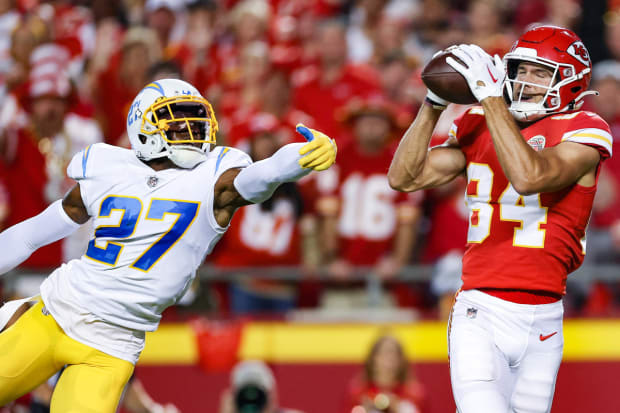
Jamie Squire/Getty Images
Held at a high school stadium on the city’s west side, the football portion of the workouts themselves lasted between 75 and 90 minutes a day, four days a week. Technically they were run by Mahomes’s personal quarterback coach, Jeff Christensen, but in practice it was the Chiefs’ leaders who took charge. “Patrick and Travis would teach all the concepts and the routes and spacing,” Christensen says. “Then Patrick took his reps with each of the receivers, good or bad, and they’d talk about it.”
Left to “sit back and watch,” Christensen emerged with two main observations. One was the way Mahomes and Kelce embraced their role as educators. “Watching their maturation, how they drove the new guys like Valdes and JuJu, was quite enjoyable for me,” Christensen says. The other was how eager these new guys were to soak up knowledge in return. After one workout, Kelce stuck around to give some pointers to some young, locally based free agents who had booked the field next. Most of the K.C. contingency had left, but Christensen remembers Valdes-Scantling hanging back, watching from a bench. “I said, ‘You’re watching Travis coach these free agents who won’t be on a roster this season?’ He said, ‘I’m trying to pick up what he’s teaching, what he’s doing. I know he’s got something there for me.”
For Valdes-Scantling, whose entire career until then had been spent running deep routes for another future Hall of Famer, the decision to sign with Kansas City largely stemmed from his desire to not sacrifice in the signal-calling department. “I had quite a few places that I could choose from, and obviously going from Aaron Rodgers to anywhere else was going to be tough,” he says. “Now, having Patrick Mahomes as my quarterback, you go from one elite-level talent to another, just a little younger.”
For Mahomes, meanwhile, the near-total overhaul of his receivers had sparked questions about just how far he could lead an offense without Hill—or, for that matter, any other elite big-play threat. “I’m sure there was a burning desire with Patrick to say, ‘I’ve got to step up and be better than ever,’” Christensen says. His new weapons heard the noise, too, but paid little mind. Why? As Smith-Schuster puts it, “Just because we don’t have Tyreek doesn’t mean we still can’t make plays and ball.”

In keeping with the standard character profile of most veteran No. 2 quarterbacks, Chad Henne carries a certain self-aware, sugarcoatless outlook on locker room matters. This holds true when the 37-year-old Henne, who came aboard with the Chiefs in 2018, the same season that Mahomes took over as starter, recounts the first and only time he accepted an invitation from Mahomes to play video games: “I think I killed myself jumping off a plane within the first, like, two seconds.” And it holds true when Henne is asked to describe the difference that Kansas City’s new receivers have made for its overall offense.
“Last year, teams could just double Kelce and double Tyreek and man up with our other guys,” Henne says. “We had so many plays designated for those two, and we wouldn’t really build upon it. And now, plays are designated for everybody. There are so many guys we can get the ball to in space.”
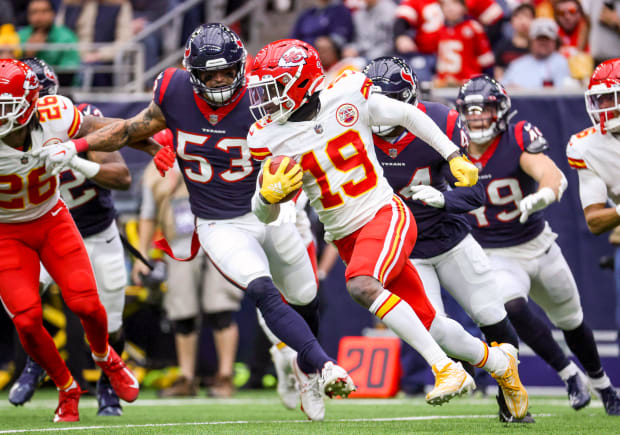
Troy Taormina/USA TODAY Sports
The stats back up the backup here. As a unit, the receivers’ most explosive effort came when Smith-Schuster and Valdes-Scantling each topped 100 yards in the team’s Week 7 road rout of the Niners, the first time two Chiefs wideouts had done so in more than two decades. In general, though, while none of these dogs are overfed, none of them go hungry either. Prior to 2022, the most receivers Mahomes had ever targeted 20-plus times each in a season was four. This year, five—Smith-Schuster, Valdes-Scantling, Hardman, Moore and Watson—finished with at least 30. “It just goes to show how diverse our offense is,” Kansas City offensive coordinator Eric Bienemey says. “It says, to a defense, that you can’t just focus on one individual.”
Compounding the confusion for opponents is the fact that Bienemeny and coach Andy Reid’s approach asks its receivers to not only line up at multiple positions—whether in the slot, out wide or even in the backfield—but also to fill a wide array of post-snap functions. “A lot of offenses, guys have specific roles that they do,” Valdes-Scantling says. “You might have one guy that’s the deep threat guy, one guy that’s the blocker, one guy that’s the short-game guy. But we’re all asked to do everything here. One week I might be running down the field deep, next week it might be J-Wat, might be Skyy. There’s just so many different guys that can do everything. That’s what makes our room so unique.”
If that wasn’t difficult enough to stop, Mahomes’s singular ability to improvise and extend plays, in turn, empowers his pass-catchers to make adjustments based on how the other team’s secondary is playing them on a given snap. “Some systems you’re just kind of set in stone where you have one route, you can only run it this way, and it has to be at this depth in this spot,” Henne says. “If it’s zone coverage, our guys know they can be in the spot, but they have flexibility of maneuvering around the linebacker, the safeties, anything like that. That’s one thing they’re really good at.”
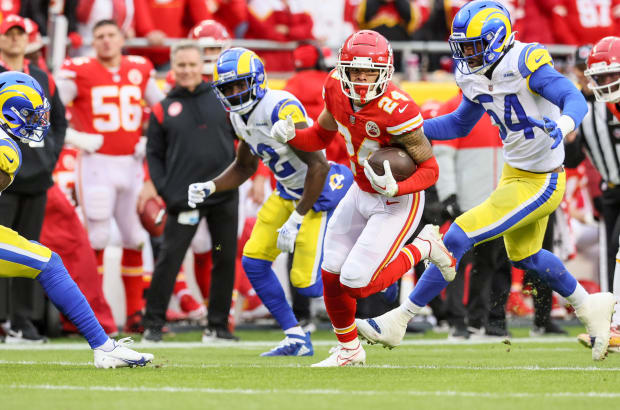
David E. Klutho/Sports Illustrated
Take, for instance, a play in the first quarter of Kansas City’s Week 12 win over the Rams, on second-and-7 from its 13. Seeing Los Angeles in a Cover-2 look, Moore took advantage of his room to improvise, wriggled outside and over the top of cornerback David Long, and hauled in an 18-yard catch to spark the Chiefs’ first touchdown drive of the day. “If we had run that play in camp, I probably would have gone inside of the corner, and [Mahomes] would’ve sat there, pump-faked it and looked elsewhere,” Moore says. “But we’re on the same page now, so we can do things like that.”
In addition to diversifying the offense—not just statistically but statureally and stylistically too, between rangy deep threats Valdes-Scantling (6'4", 206) and Watson (6'2", 215); smaller shiftsters in Hardman (5'10", 187) and Toney (6'0", 193); and Smith-Schuster (6'1", 215), whom Bienemy calls “pound-for-pound the toughest” of the bunch—this new-look receiving unit has benefitted Kansas City’s offense in several other ways. Depth is one, with Hardman and Toney each spending time on injured reserve this season. “On top of that,” Bienemy says, “Pat is growing in this offense because he’s not just reliant on one particular individual to make things happen. I know [defenses] put a lot of attention on Travis Kelce, but there’s also a number of receivers out there who can make some plays.”
If the wideouts are indeed anime ninjas, then it stands to reason that Bienemy is their lead animator, tapping into their superpowers, sketching out their acts of heroism one playbook page at a time. Asked to describe Mahomes’s new supporting castmates, Bienemy, who likewise has been in his current role with the Chiefs since 2018, chuckles. “As a group, it’s very loud,” he says. “And I don’t mean that in a bad way. They're always supporting one another, and that’s huge. They’re their biggest fans.”
In addition to his in-game duties with the Steelers, which largely pigeon-holed him into lining up from the slot, Smith-Schuster often filled the role of host for gatherings among Steelers players. Joining the Chiefs, then, he was pleasantly surprised when the first such function was held at the home of Pro Bowl left tackle Orlando Brown Jr. “It was like my first time actually doing that, not hosting,” Smith-Schuster says. “It’s really cool to see the leaders building that connection with everyone here.”
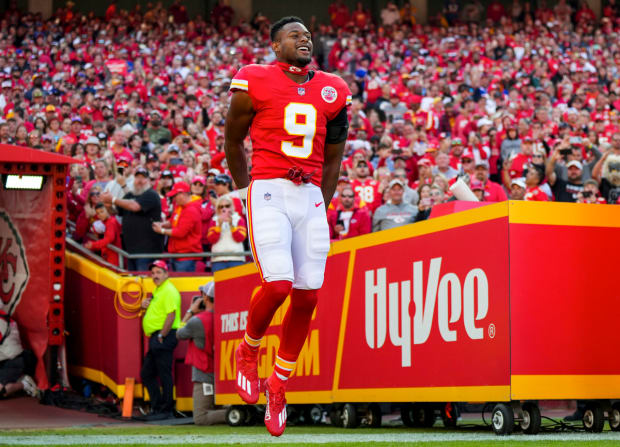
Cooper Neill/Getty Images
Similar connections have been forged within the K.C. WR room itself over trips to dinners, to movies, to Sporting Kansas City games; the day after Thanksgiving, a handful of them went to see the rapper Kodak Black. Ever the outgoing personality, Smith-Schuster has done his fair share of entertaining too. “Huge couch,” Watson says. “You could tell he had that place in line for having people over. That’s what’s fun, man. When I came to Kansas City, I’d never been this far in the middle of the country. And so to have guys always hosting, always watching Thursday Night Football or Monday Night Football, it just makes it feel like a team and it makes it feel like a family.”
Christensen witnessed the early signs of this close-knit-ness in Fort Worth, as Mahomes and his new weapons worked to establish a rhythm. “There were a couple times when [Mahomes] missed JuJu and Valdes three times in a row each, because they either went a little too far upfield or came out of their routes at the wrong angle,” Christensen recalls. “And the fourth time it was perfect. The willingness to miss and miss and miss, with zero angst or ego—where I think [the Chiefs] are ahead of everybody else in the league is that they find good-hearted guys who care about being in a cohesive unit.”
The result is the sort of selfless mindset necessary to succeed in an offense whose top scoring threats are a tight end and a running back (Jerick McKinnon, career-high 9 TD catches in the regular season). None are bona fide No. 1 receivers, but this weekend they will take the field at Arrowhead Stadium determined to prove that greater strength exists in numbers.
A red moon is rising. The dogs are barking.







